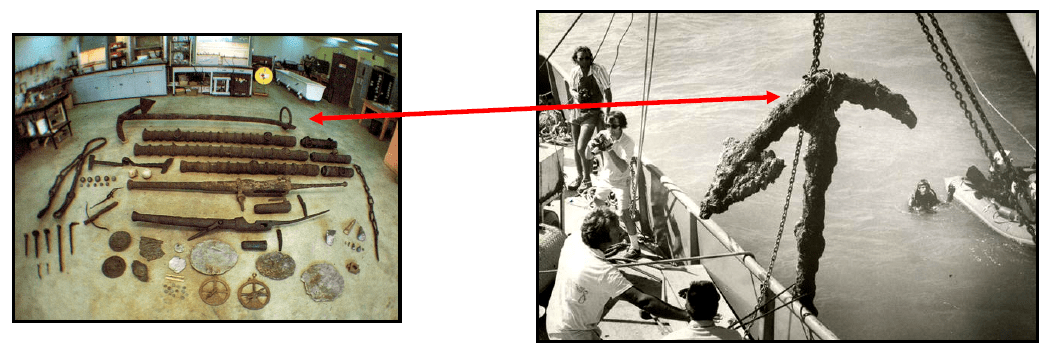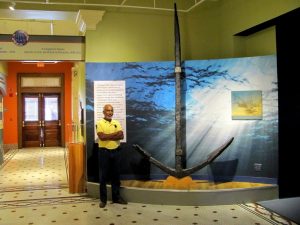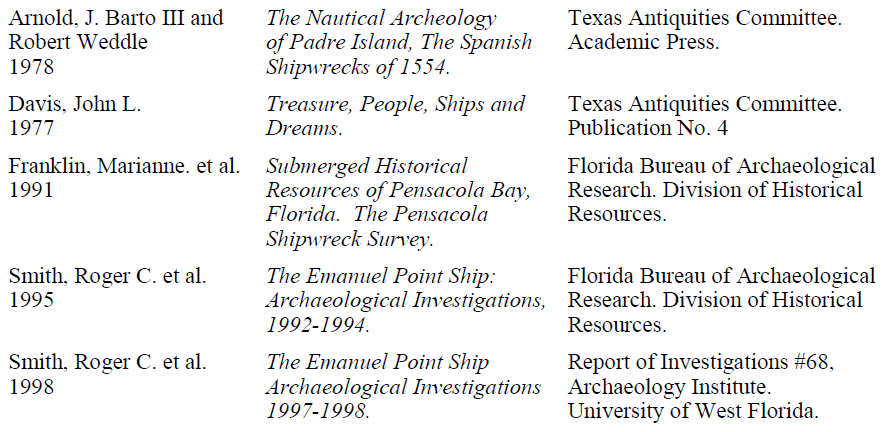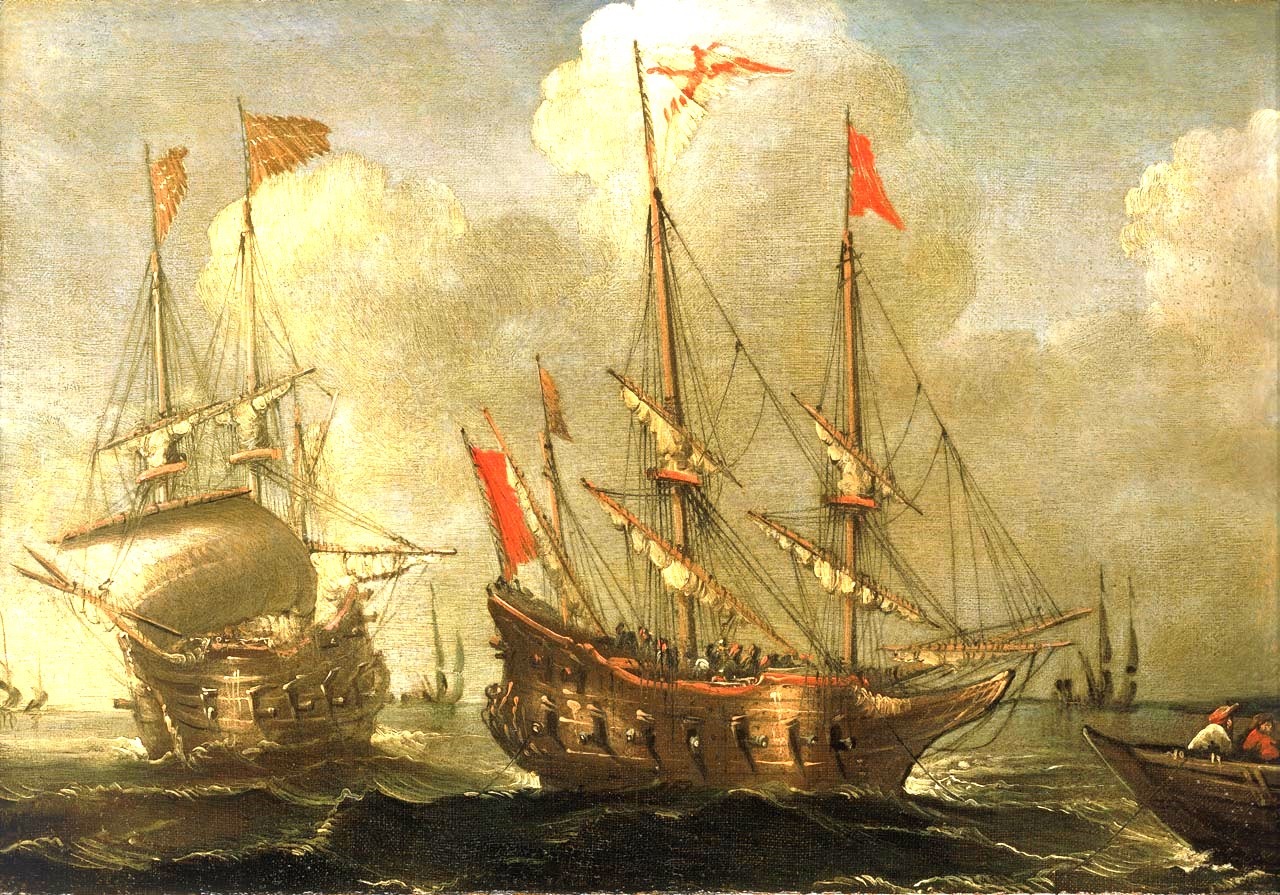Comparisons of Two 16th-Century Spanish Anchorages on the Northern Gulf Coast
Contact Archeology Inc. (CAI)
November 2020
by: Caleb Curren
(Editorial Board: David Dodson, Pamela Corey, Jerry Gill)
Abstract
This article compares the anchorages of two Spanish fleets that were wrecked by storms during the 1500s on the northern coast of the Gulf of Mexico. The comparisons are very interesting for a number of reasons. The anchorage of one of the fleets has been found. The anchorage of the other has not and is crucial in the archeological confirmation of the earliest multiyear European settlement in the current United States.
The 1554 Shipwrecks on Padre Island, Texas
Three Spanish ships were wrecked by a storm in 1554 on a barrier sand spit known today as Padre Island in current south Texas. They were part of a fleet of four ships carrying a large treasure of goods, precious metals, and jewels back to Spain from the New World of Central and South America. A violent storm struck the fleet while the vessels were at sea off Cuba and drove them northwest across the Gulf of Mexico until Padre Island loomed in sight off their bows. They could not deploy their multiple anchors in the deep gulf in a major storm but when they approached the shallows off Padre Island they desperately set all their anchors so as not to be grounded and destroyed. The anchor lines soon broke and a terrible ordeal of fierce Native attacks and starvation awaited them in the barren lands of south Texas.
In 1972-1978 archeologists from the State of Texas conducted underwater excavations on one of the three 1554 Spanish shipwrecks. The research was extensive and one of the hallmarks of underwater archeology in the United States. A detailed technical report was published as well as scientific articles and general public releases.
The Texas archeologists recovered nine anchors from the desperate attempt by the Spaniards to save their ships. It is clear that the anchorage of the three doomed ships has been established.

The 1559 Shipwrecks in Pensacola Bay
The 1559 Spanish shipwrecks in Pensacola Bay, Florida, are a much different situation than those off Padre Island, Texas, yet they are linked in the overall Spanish economic/military plan of the rulers of the Spanish Empire at this time. The Pensacola fleet was not carrying treasure such as that on the Padre Island shipwrecks, rather, they were charged with establishing multiple colonies on the Gulf of Mexico, the interior of the continent, and the Atlantic Coast to secure Spanish land claims and set up ports to protect Spanish treasure fleets such as the ships wrecked on Padre Island.
Twelve known ships of various sizes entered Pensacola Bay on August 15, 1559, and established an anchorage for their fleet. Their anchoring was conducted in a relatively calm manner as opposed to the terror during the anchorage attempt off Padre Island. That calmness was short-lived. A violent storm beset the fleet; broke the anchor lines, and scattered the fleet.
The anchors from the fleet were left on the bottom of the bay. The Spanish Viceroy wanted the anchors salvaged and reset as moorings for surviving ships and the resupply ships arriving later. There is no documentary proof that this order was ever carried out or even attempted. It is very likely that the anchors of the fleet still lie today at their original anchorage in the deep mud of the bottom of Pensacola Bay.
The State of Florida began systematic surveys for shipwrecks in Pensacola Bay in 1990. A stone ballast pile was found in 1992, which turned out to be the remains of a shipwreck associated with the 1559 Spanish fleet. Since the initial discovery, 14 years of extremely unique and important excavations and underwater surveys have been conducted by the State of Florida. A total of three shipwrecks of the 1559 fleet have been located.
However, the anchorage of the 1559 Spanish fleet has yet to be located. Only one broken anchor has been found on one of the shipwrecks. According to the discoverers, it was likely nonfunctional and lashed to the starboard side of the ship.
The importance of locating the original 1559 Spanish fleet anchorage has multiplistic importance. The anchors themselves would provide researchers with data concerning anchor construction of the period. The anchor cluster would indicate what mariners of the time considered a safe harbor. Most importantly, to find the anchorage of the 1559 fleet would aid us in locating the Spanish colony established on land adjacent to the anchorage.
There are at this time more questions than answers, but we can say some things with certainty. It was best written by the marine archeologist, Dr. Roger Smith, who spearheaded the exploration for the 1559 shipwrecks and anchorage of the Spanish fleet. He wrote of the first 1559 Spanish shipwreck his team discovered:
“… this consolidated pile of stones was found in shallow water, on a sandbar that provides poor holding ground and an unprotected anchorage for ships of any size … the ship appears to have grounded during a violent storm of sufficient severity to break open its hull by pounding on the sandbar during heavy seas.”
In other words, the mariners of the 1559 Spanish expedition would never have allowed their ships to be anchored in such a shallow and unprotected area with a bay bottom not capable of securing the anchors of their ships.

Broken anchor, E.P. 1
Conclusions:
The anchorage of the three 1554 Padre Island shipwrecks in Texas has been found.
The anchorage of the 1559 Pensacola Bay shipwrecks in Florida has not been found.
Until the anchorage of the 1559 Pensacola Bay fleet has been found, shipwrecks of the fleet scattered by the storm cannot legitimately be used to support the settlement site of the Luna Colony on land.
Related Documents


A Spanish fleet at anchor. (public image)
- Article
-
Abstract
This article compares the anchorages of two Spanish fleets that were wrecked by storms during the 1500s on the northern coast of the Gulf of Mexico. The comparisons are very interesting for a number of reasons. The anchorage of one of the fleets has been found. The anchorage of the other has not and is crucial in the archeological confirmation of the earliest multiyear European settlement in the current United States.
The 1554 Shipwrecks on Padre Island, Texas
Three Spanish ships were wrecked by a storm in 1554 on a barrier sand spit known today as Padre Island in current south Texas. They were part of a fleet of four ships carrying a large treasure of goods, precious metals, and jewels back to Spain from the New World of Central and South America. A violent storm struck the fleet while the vessels were at sea off Cuba and drove them northwest across the Gulf of Mexico until Padre Island loomed in sight off their bows. They could not deploy their multiple anchors in the deep gulf in a major storm but when they approached the shallows off Padre Island they desperately set all their anchors so as not to be grounded and destroyed. The anchor lines soon broke and a terrible ordeal of fierce Native attacks and starvation awaited them in the barren lands of south Texas.
In 1972-1978 archeologists from the State of Texas conducted underwater excavations on one of the three 1554 Spanish shipwrecks. The research was extensive and one of the hallmarks of underwater archeology in the United States. A detailed technical report was published as well as scientific articles and general public releases.
The Texas archeologists recovered nine anchors from the desperate attempt by the Spaniards to save their ships. It is clear that the anchorage of the three doomed ships has been established.

One of the 9 anchors from the Padre Island shipwreck. (State of Texas photos) The 1559 Shipwrecks in Pensacola Bay
The 1559 Spanish shipwrecks in Pensacola Bay, Florida, are a much different situation than those off Padre Island, Texas, yet they are linked in the overall Spanish economic/military plan of the rulers of the Spanish Empire at this time. The Pensacola fleet was not carrying treasure such as that on the Padre Island shipwrecks, rather, they were charged with establishing multiple colonies on the Gulf of Mexico, the interior of the continent, and the Atlantic Coast to secure Spanish land claims and set up ports to protect Spanish treasure fleets such as the ships wrecked on Padre Island.
Twelve known ships of various sizes entered Pensacola Bay on August 15, 1559, and established an anchorage for their fleet. Their anchoring was conducted in a relatively calm manner as opposed to the terror during the anchorage attempt off Padre Island. That calmness was short-lived. A violent storm beset the fleet; broke the anchor lines, and scattered the fleet.
The anchors from the fleet were left on the bottom of the bay. The Spanish Viceroy wanted the anchors salvaged and reset as moorings for surviving ships and the resupply ships arriving later. There is no documentary proof that this order was ever carried out or even attempted. It is very likely that the anchors of the fleet still lie today at their original anchorage in the deep mud of the bottom of Pensacola Bay.
The State of Florida began systematic surveys for shipwrecks in Pensacola Bay in 1990. A stone ballast pile was found in 1992, which turned out to be the remains of a shipwreck associated with the 1559 Spanish fleet. Since the initial discovery, 14 years of extremely unique and important excavations and underwater surveys have been conducted by the State of Florida. A total of three shipwrecks of the 1559 fleet have been located.
However, the anchorage of the 1559 Spanish fleet has yet to be located. Only one broken anchor has been found on one of the shipwrecks. According to the discoverers, it was likely nonfunctional and lashed to the starboard side of the ship.
The importance of locating the original 1559 Spanish fleet anchorage has multiplistic importance. The anchors themselves would provide researchers with data concerning anchor construction of the period. The anchor cluster would indicate what mariners of the time considered a safe harbor. Most importantly, to find the anchorage of the 1559 fleet would aid us in locating the Spanish colony established on land adjacent to the anchorage.
There are at this time more questions than answers, but we can say some things with certainty. It was best written by the marine archeologist, Dr. Roger Smith, who spearheaded the exploration for the 1559 shipwrecks and anchorage of the Spanish fleet. He wrote of the first 1559 Spanish shipwreck his team discovered:
“… this consolidated pile of stones was found in shallow water, on a sandbar that provides poor holding ground and an unprotected anchorage for ships of any size … the ship appears to have grounded during a violent storm of sufficient severity to break open its hull by pounding on the sandbar during heavy seas.”
In other words, the mariners of the 1559 Spanish expedition would never have allowed their ships to be anchored in such a shallow and unprotected area with a bay bottom not capable of securing the anchors of their ships.

Broken anchor, E.P. 1
Conclusions:
The anchorage of the three 1554 Padre Island shipwrecks in Texas has been found.
The anchorage of the 1559 Pensacola Bay shipwrecks in Florida has not been found.
Until the anchorage of the 1559 Pensacola Bay fleet has been found, shipwrecks of the fleet scattered by the storm cannot legitimately be used to support the settlement site of the Luna Colony on land. - Related Documents
-
Related Documents


A Spanish fleet at anchor. (public image)
- Download PDF Version